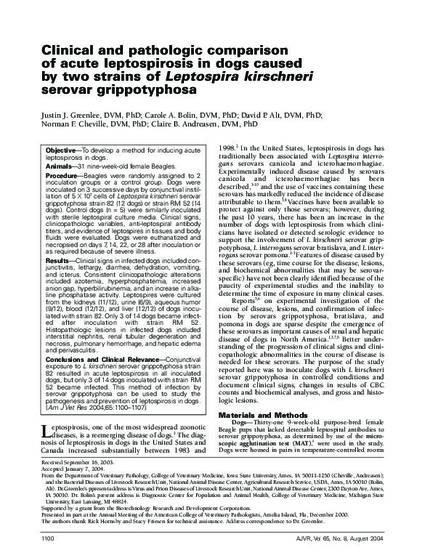
Article
Clinical and Pathologic Comparison of Acute Leptospirosis in Dogs Caused by Two Strains of Leptospirosis Kirschneri Serovar Grippotyphosa
American Journal of Veterinary Research
Document Type
Article
Disciplines
Publication Version
Published Version
Publication Date
8-1-2004
Abstract
Objective—To develop a method for inducing acute leptospirosis in dogs. Animals—31 nine-week-old female Beagles. Procedure—Beagles were randomly assigned to 2 inoculation groups or a control group. Dogs were inoculated on 3 successive days by conjunctival instillation of 5 X 107 cells of Leptospira kirschneri serovar grippotyphosa strain 82 (12 dogs) or strain RM 52 (14 dogs). Control dogs (n = 5) were similarly inoculated with sterile leptospiral culture media. Clinical signs, clinicopathologic variables, anti-leptospiral antibody titers, and evidence of leptospires in tissues and body fluids were evaluated. Dogs were euthanatized and necropsied on days 7, 14, 22, or 28 after inoculation or as required because of severe illness. Results—Clinical signs in infected dogs included conjunctivitis, lethargy, diarrhea, dehydration, vomiting, and icterus. Consistent clinicopathologic alterations included azotemia, hyperphosphatemia, increased anion gap, hyperbilirubinemia, and an increase in alkaline phosphatase activity. Leptospires were cultured from the kidneys (11/12), urine (6/9), aqueous humor (9/12), blood (12/12), and liver (12/12) of dogs inoculated with strain 82. Only 3 of 14 dogs became infected after inoculation with strain RM 52. Histopathologic lesions in infected dogs included interstitial nephritis, renal tubular degeneration and necrosis, pulmonary hemorrhage, and hepatic edema and perivasculitis. Conclusions and Clinical Relevance—Conjunctival exposure to L kirschneri serovar grippotyphosa strain 82 resulted in acute leptospirosis in all inoculated dogs, but only 3 of 14 dogs inoculated with strain RM 52 became infected. This method of infection by serovar grippotyphosa can be used to study the pathogenesis and prevention of leptospirosis in dogs.
Rights
Works produced by employees of the U.S. Government as part of their official duties are not copyrighted within the U.S. The content of this document is not copyrighted.
Language
en
File Format
application/pdf
Citation Information
Justin Jay Greenlee, Carole Ann Bolin, David P. Alt, Norman Cheville, et al.. "Clinical and Pathologic Comparison of Acute Leptospirosis in Dogs Caused by Two Strains of Leptospirosis Kirschneri Serovar Grippotyphosa" American Journal of Veterinary Research Vol. 65 Iss. 8 (2004) p. 1100 - 1107 Available at: http://works.bepress.com/claire_andreasen/20/

This article is from American Journal of Veterinary Research 65 (2004): 1100.